Review for Miss Hokusai
Introduction
This review was supposed to be posted way back in Spring, but the release got delayed at the last minute, for some added goodies. Miss Hokusai is now available as an Ultimate Edition, coming in a wooden box of all things, with a far heftier collector’s book with it. You’ll have to forgive the review for not quite being as up to date, as I don’t have time to re-watch the film to properly amend the review...
Miss Hokusai was going to be the second feature film to be released by All the Anime in 2016, but it bears remarkable similarities to the first, Fusé: Memoirs of a Huntress. Both are set in historical Edo, both have elements of the supernatural in their storylines, and both are narrated by, for the period unlikely protagonists, women. It may be purely coincidental, but both films too are lavish works of art, the kind of film where you can press pause at any moment, and have an image worthy of display. It also might be fun to compare and contrast how both films approach their moments of similarity; both films have scenes set in the courtesan district. The difference of course is that rather than an adaptation of a historical fantasy, Miss Hokusai is actually an anime historical biopic, although one with a strong fictional element to it.
The eponymous Miss Hokusai, O-Ei and her father Tetsuzo, a.k.a. Katsushika Hokusai were artists that lived during the first half of the nineteenth century, and Hokusai’s artwork has international acclaim; you’ll probably have seen The Great Wave of Kanagawa, and he inspired a whole generation of European artists. His daughter O-Ei served as his assistant, although the debate remains as to just how much of an artist she was in her own right.
The summer of 1814 in Edo was a significant year for O-Ei and her father. He was a man who was wholly devoted to his art, living separately from his family, even shunning the usual vices that men usually pursue. He sets up shop in whatever building is convenient, and even has a disciple, while already his reputation is such that he’s often commissioned to create works of art. His temperament is such that any whim can distract him, he can be easily bored, and so it is that the burden of completing his work (or creating it in the first place in some instances), falls to his daughter O-Ei, who serves as his assistant, and has also inherited his less favourable personality traits. She also serves as the bridge between him and the rest of his family, including her younger sister, the blind O-Nao. She also has certain things to learn before she can become an artist in her own right.
Picture
Miss Hokusai gets a 1.78:1 widescreen transfer at 1080p resolution, and on this disc, it’s a nigh on impeccable presentation. The image is clear and sharp throughout, colours are strong and consistent, black levels are fine, and there’s no visible sign of compression, or even digital banding. And that’s just what you would expect in a film as visually oriented as this, as Production IG apply their considerable talents to bringing historical Edo to life, rendering the film with strong, fluid, and vibrant animation, memorable and distinctive character designs, and the confidence to switch the style of the animation when the story demands it.
The images in this review were kindly supplied by All the Anime.
Sound
You have the choice between DTS-HD MA 5.1 Surround and 2.0 Stereo in both Japanese and French. The Japanese audio offers the choice of English and French subtitles, while the French audio comes with a French signs and screen text only track. The audio and subtitle options are locked during playback. I went with the Japanese with English subtitles naturally, and was happy enough with the presentation. The subtitles were timed accurately and free of typographical error, while the dialogue was clear throughout. The film gets a very nice, subtle sound design, really immersing you in the ambience of early nineteenth century Edo, although the music soundtrack seemed a little eclectic in comparison. Certainly moments of rock and roll guitar seemed out of place given the period, although not totally out of place given the independent characterisation of O-Ei.
Extras
I’m just reviewing the standard Blu-ray release here, which is a French English co-author between All the Anime, and their French partner @Anime, which is a barebones release. You really want the Ultimate Edition for the extra goodness of art packaging, and naturally for a film about artists, you’ll want the art book and art cards. The Ultimate Edition also gets a bonus DVD with a making of documentary and an interview with the director.
This standard Blu-ray release and the standard DVD release get nothing.
Conclusion
Another thing that Miss Hokusai has in common with Fusé: Memoirs of a Huntress is that both films are better served with context. Appreciating Fusé is made easier by being aware of the myths and stories that inspired it, and in that same vein, Miss Hokusai gains depth and historical weight once you know more about Katsushika Hokusai and his daughter O-Ei. Hopefully in this instance that weight is supplied by the Ultimate Edition material, the bonus documentary and the art book. In its barebones edition, taking this Blu-ray on its own merits, Miss Hokusai is an entertaining, enjoyable, historical, slice of life piece, a light drama, with light comedy, and light supernatural elements; the operative word being ‘light’
Miss Hokusai doesn’t really have a narrative, no beginning, middle and end, rather it’s a film that sets out to capture moments in life, snapshots really that explore character and emotion, and again really with an ephemeral touch. You have this set-up of a father estranged from his family, except for O-Ei who is his assistant, and the bohemian lifestyle that comes from a single-minded pursuit of art. Events occur, commissions are made and we see the great Hokusai at work, or his daughter. We see O-Ei’s proficiency, but then we also see how much she has to learn. A depiction of hell causes problems as she forgot to add the possibility of redemption with the figure of a Buddha, something her father points out. Her erotica is accurate, but lacks sensuality, something that comes down to her lack of experience, although her solution cuts through to the heart of the matter in a shocking way.
The textual narrative isn’t really as important as the visual, as this film really comes to life in the way that it depicts art, how artists work, and how they are inspired. One key moment in the film involves O-Ei spending time with her sister O-Nao, and the different ways in which they perceive the world. A simple riverboat trip, the experience of flowing water, and waves, is transformed through the animation into that iconic artwork synonymous with Hokusai. And there are other similar moments throughout the film which can captivate the eyes.
The emotional arcs in the film are underplayed almost to the point of becoming a detriment to the film. A potential love interest is raised early on in the film, but is dismissed with a minor turn of events, and is never thought of again. And towards the end of the film, when a tragedy strikes, it is saddening, but it’s also dismissed, the characters move on; it’s just the way life goes, and it seems the viewer is more affected than the characters. This is a film where the viewer has to infer emotional context to events and characters, rather than have it spelled out, which in some ways is refreshing, but can also fall flat. One aspect that worked was the distance between Hokusai and his youngest daughter O-Nao, where she wonders whether her father hates her, while he in turn finds it hard to connect with her, and I was struck by the irony of a man who devotes his life to the visual arts with a daughter unable to appreciate any of that.
If a film’s effectiveness is in the ability to evoke empathy in the viewer, then Miss Hokusai certainly succeeds. It’s an enjoyable film, at times funny, at times moving, and on occasions inspiring. It’s not a conventional film in any sense of the word. While you watch it, it feels like a collection of vignettes, often unconnected moments in the lives of these characters. But once the end credits roll, there is a sense of a cohesive whole to the film, an ongoing story. The life of Miss Hokusai in this film might be as light, fleeting, and un-impactful as her recorded historical significance, but this is very much a film that you will watch more than once, not least for its visual prowess.
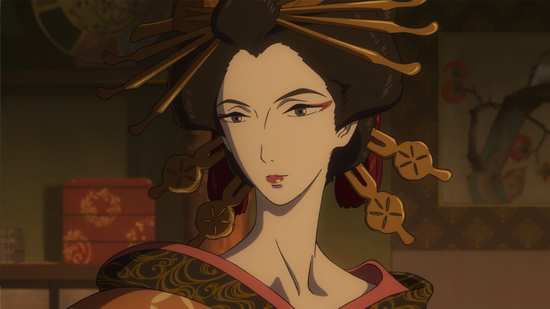
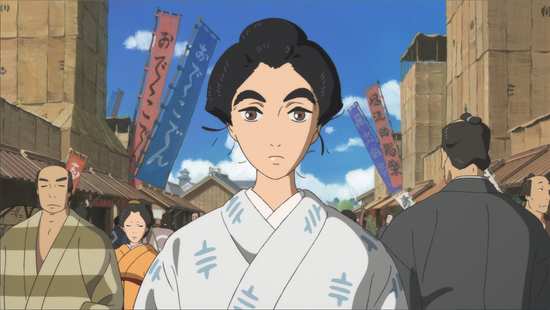
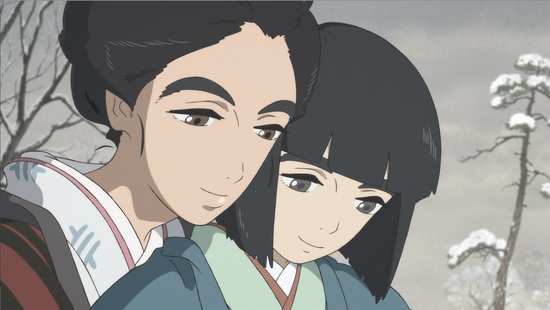
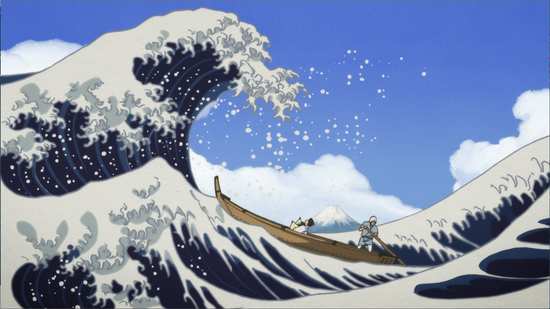
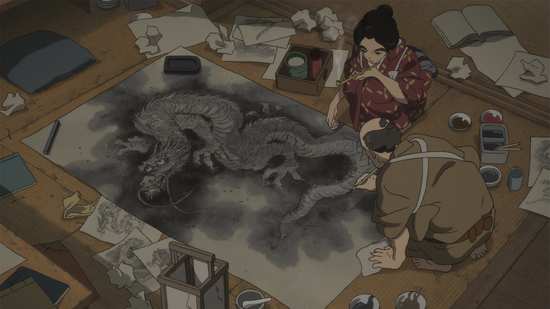
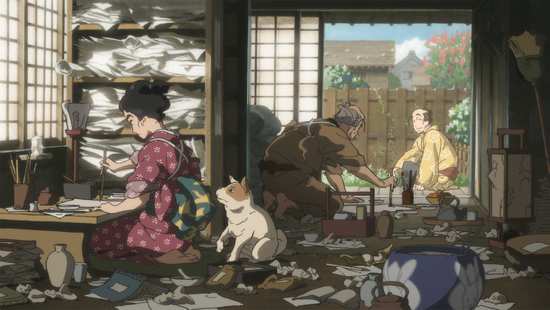
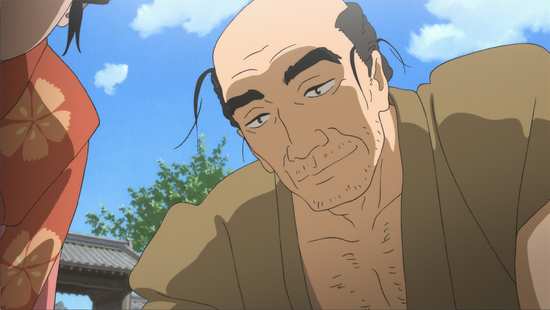
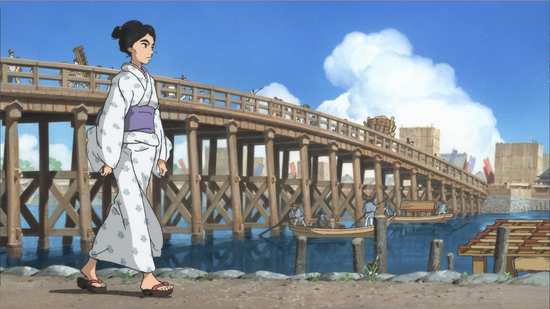

Your Opinions and Comments
Be the first to post a comment!